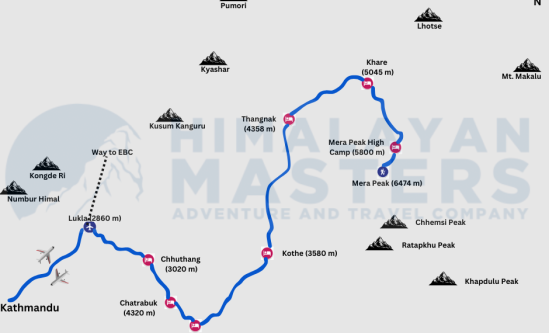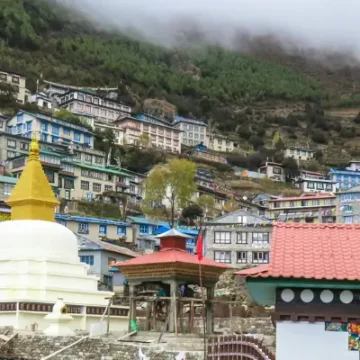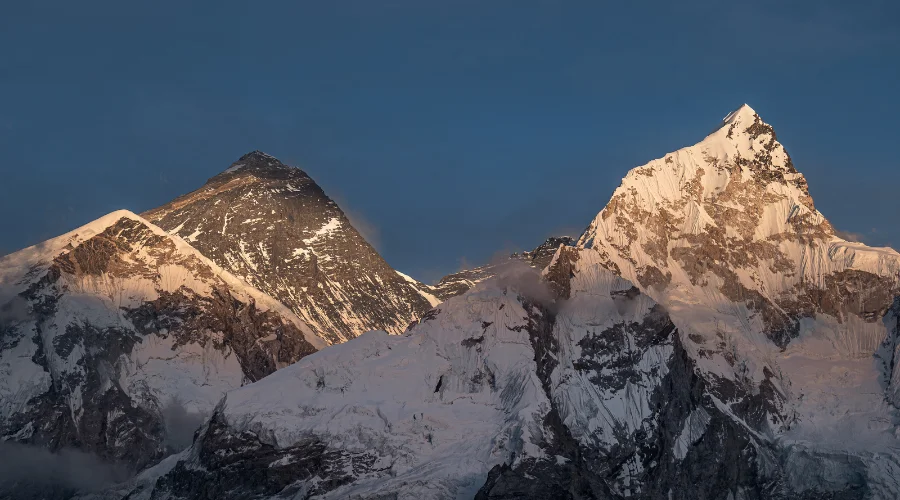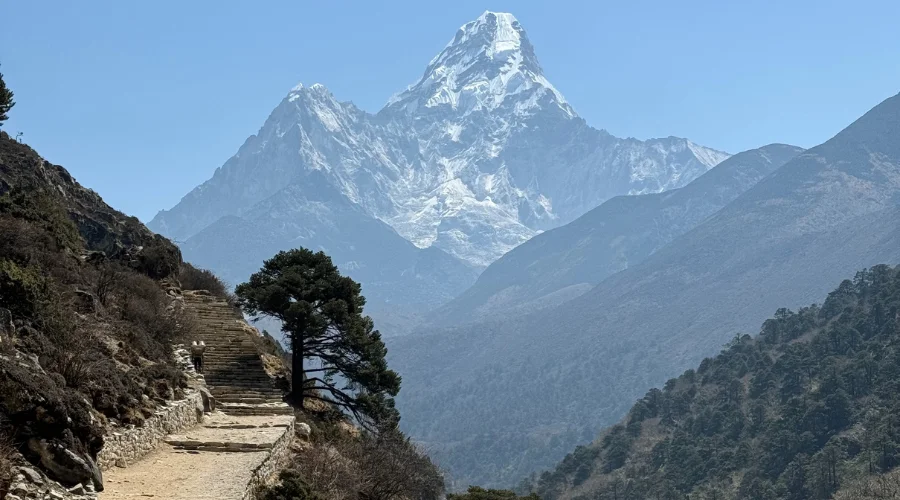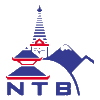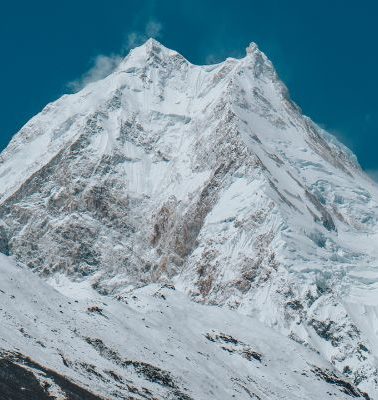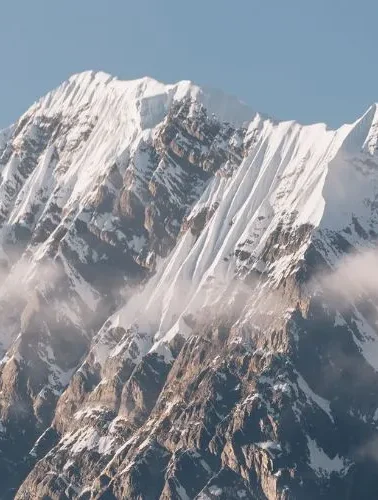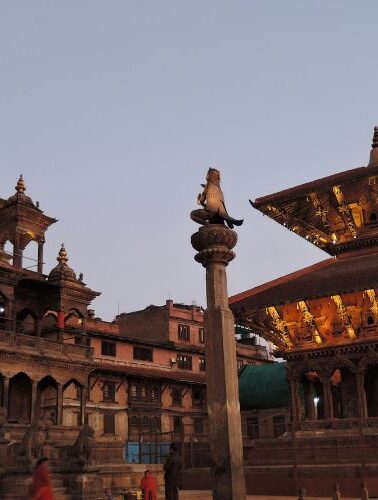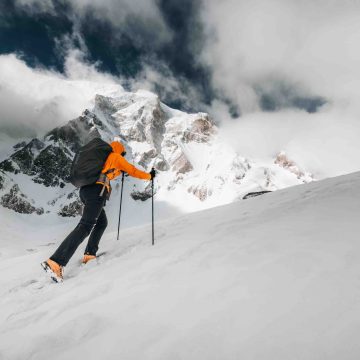
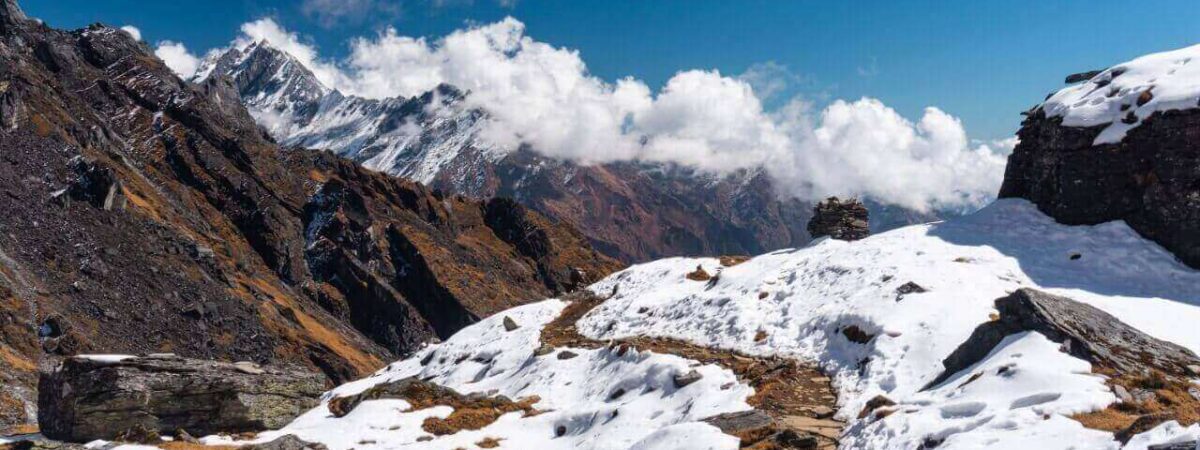
- TRIP DURATION
- 17 Days
- MAX. ALTITUDE
- 6400
- TRIP GRADE
- hard
- LODGING
- Tea house and tent
- BEST SEASON
- Springs and autumn
- MEALS
- Breakfast lunch dinner
- COMMUNICATION
- Local sim card
- PER DAY WALK
- 5 to 6 hours
Mera Peak Climbing
Right next to Mount Everest lies the highest trekking peak in Nepal, Mera Peak. The possibility of an actual mountain climb with minimum trekking experience has made Mera Peak among the most popular trekking peaks in Nepal. And the sense of Victory is worth it. At 6,476 meters above sea level, Mera Peak is the highest you can go without mountain climbing permits. This Mera peak climbing is perfect for experienced trekkers and new climbers.
The Mera Peak climb can be a practice peak if you plan to conquer other high peaks in Nepal above 8,000 meters. Most importantly, you can experience the thrill of Mera peak climbing without having to pay thousands of dollars for a climbing permit. Mera peak climbing price is affordable. This short 17-day journey gives a wholesome natural and cultural experience.
Mera Peak is itself the highest form of adventure. However, the views of the world’s highest peaks, like Mt. Everest, Mt. Lhotse, Mt. Cho Oyu, Mt. Makalu, and Mt. Kanchenjunga, make it even more enjoyable. Added to these interesting views, Everest’s unspoiled landscape and rich biodiversity make everything exciting.
Mera peak climbing commences with a Lulka flight from Kathmandu. From Lukla, we leave the classic Everest Base Camp route and head to Chhuthang. Crossing our first high passes at Zatrawala, we get to Tuli Kharka and walk to Kothe. Then, we get to Thangnak, reach Khare, and finally land at Mera Base camp. We must settle here for a day before climbing High Camp and eventually conquering the summit.
After the beautiful Victory, we plan to get back to Khare. On the same way back, we get to Kothe and Tuli Kharka. Climbing the Zatrawal one last time, we get to Lukla and fly to Kathmandu. Although you leave the mountains, the memories of the trip will remain with you forever.
Mera Peak Climbing Highlights
- Conquer the highest altitude trekking peak of Nepal at 6746 meters
- Experience in actual mountain climbing without having to issue a climbing permit
- A thrilling flight to Lukla for the experience of a mountain flight
- The incredible landscape of the Khumbu region, including Lukla, Hinku Valley, and Yak pastures
- Get all training and mountain climbing skills from our expert guide and Sherpas
- Experience the remote Lifestyle and unique culture of Sherpas that would take you a few centuries back
- Insight of wild flora and fauna that are only seen in the subtropical and alpine lands of Nepal
- One of the simpler 6000-meter peaks to climb is the Mera Summit.
Mera Peak Support Team
Since we are planning our journey, our experienced guides and climbers will be available for advice. Your support team will have one porter per person and one guide for a group of 4-5 people.
You’ll travel with skilled guides who have led Mera peak trekking groups multiple times and know much about high-altitude trips. They will help you plan with information and support. Our advice on dealing with high altitudes is essential. Your Support will be with you the whole time to ensure you’re safe and happy. During sickness and emergency, they will also be responsible to take you to safety.
Porters will carry up to 15 kg of your main bag and take care of all group needs. We ensure our Sherpa guides and local staff have insurance if something goes wrong on Mera Peak expedition.
Why Mera Peak Expedition with Himalayan Masters?

Himalayan Masters, an adventure company, organizes trekking and mountaineering in Nepal’s Himalayas. We provide climbing skills training, covering techniques like glacier walks and fixed rope use. With a 99% success record in Mera Peak trekking summits, we prioritise safety. Our competitive Mera Peak Climbing cost includes nominal service charges, and the professional team can adjust the itinerary based on field conditions.
ITINERARY
Day 01: Arrival at kathmandu
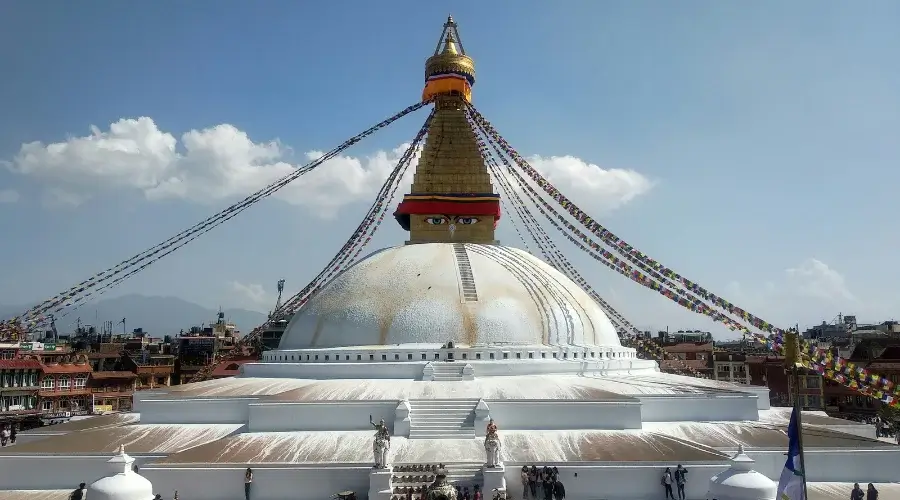
When you arrive at the international airport of Nepal, there will be a driver waiting for your arrival. Luxurious drive in a private vehicle along the smooth roads of Kathmandu is itself fun. Reaching the hotel, you will have a lot of private time for refreshments. In last, we gather for a few minutes for the briefing session. Meting some members of the team, we celebrate your arrival with a welcome dinner.
Overnight in Kathmandu
Day 02: Climbing Preparation and Sightseeing around Kathmandu
Altitude: 1400m
An additional day in Kathmandu during this Mera Peak Itinerary is itself very interesting. In the morning, we get around some of the UNESCO world heritage sites like Swayambhunath and Pashupatinath. After that, we drive to Balaju for the rock climbing training. For a few hours, the Himalayan master’s expert guide helps you learn the techniques to use ropes, crampons, and axes. Then, we drive back to our hotel in Thamel. Engaging in shopping/ renting trekking gear, we pack your bags and get ready for the trek.
Overnight in Kathmandu
Day 03: Flight to Lukla (25 min) and trek to Chhuthang
Altitude: 3020m
Duration: 4-5 hours

In the morning, we start the day by driving to the airport. After the paper works, we hop on a domestic flight to Lukla. For the next 25 minutes, you will be delighted with parallel views of the mountain vistas. Landing on Lukla, you will be in a totally different landscape. Here, we met our porters and Sherpas for the first time.
After getting a local area permit here, we move towards Chhuthang. Crossing the village via the Kalo Khola ridge, we cross thick subtropical forests. In the Chhuthang, we set our first camp during the Mera Peak trip.
Overnight in Chhuthang
Day 04: Trek to Chatrabuk
Altitude: 4320m
Duration: 5-6 hours
From Chhuthang, we start climbing at 4,200 above sea level. Today’s steep climb at Zatrawala pass gives you an idea about the difficulty of Mera peak climbing. From the top of the pass, we can see Kongdi Ri, Karyolang Peak, Number Himal, and Lumding Himal. This Zatrawala actually separates Khumbu and Hinku valley during the Mera Peak trip. Then, we descend to Chatrabuk for a short time and crash at a camp here.
Overnight in Chatrabuk
Also check our easy Chitwan National park tour.
Day 05: Trek to Kothe
Altitude: 3580m
Duration: 5-6 hours
After breakfast, we move on a zigzagged trail of rhododendron trees. Since the area is mostly empty, we cannot see much human settlement until Kothe. With the awesome view of Mera Peak before us, the path takes us to Kothe for the night. It’s a beautiful day on our Mera peak trip.
Overnight in Kothe
Day 06: Trek to Thangnak
Altitude: 4358m
Duration: 3-4 hours
From Kothe, we move to the Upper section of Hinku valley for the most delightful view of the Kusum Kanguru (6,367m). We stop at a small local Gompa that has been camouflaged beautifully in the rocky setting. Then, we walk slowly towards the Thangnak.
Overnight in Thangnak
Day 07: Acclimatization Day
Thangnak is actually a very beautiful place for acclimatization. Stopping here for a day allows us to adapt to the low oxygen level. However, we keep ourselves active by exploring the nearby hills and villages. We shall burn the campfire and have awesome memories of the trip.
Overnight in Thangnak
Day 08: Trek to Khare
Altitude: 5045m
Duration: 3-4 hours
From Thangnak, it’s a rather easy and short climb to Khare. We only walk for 3 to 4 hours in the morning and stop here for some acclimatization. This is the final settlement before the Mera peak base camp and we can clearly see the range of Mera, Kusum Kanguru, and Kyashar mountains.
Overnight in Khare
Day 09: A day for further acclimatization
This is our last stop before we head for the Mera Peak

summit climb. We plan to take short hikes around the village and learn some mountaineering skills. You will learn to use crampons, axes, and rope to tackle the difficult section of the trip. If you develop any difficulty at this height, we wouldn’t move any further for Mera Peak climbing.
Overnight in Khare
Day 10: Trek to High Camp
Altitude: 5800m
Duration: 5-6 hours
This is the easier day of our attempt at the summit. From Khare, we shall first climb to the Mera La pass at the height of 5415m. In a few hours, we will already be in the Mera Base Camp. Here, we can see many colorful camps built by the trekkers who are about to climb the Mera Peak summit. We also set our camps before the fantastic panoramic views of the Himalayas and sleep right at the base of the mountain.
Overnight in High Camp
Day 11: Climb to Mera Peak and back to Khare
Altitude: 6476m (Mera peak); 5000m (Khare)
Duration: 8-9 hours

This is going to be the longest and the hardest day of our Mera peak climb. We start the hike while it’s still dark and start walking with the help of a torch. As the sun rises, we can see the golden range of the mountains smiling at us. Climbing to Mera peak at High camp altitude is really challenging. The last part of the climb is very steep and you need to be careful with the instructions. Getting to the top, you can see the views of Everest, Makalu, Lhotse, Cho Oyu, and Kanchenjunga. We plan to reach the summit before mid-day as the wind after that is really strong. Then, we walk for about four hours to Khare.
Overnight in Khare
Day 12: Reserve day for climbing
In case of unstable weather, we wouldn’t climb the summit on the proposed day. Also, there might be times when you cannot climb due to sickness. So, this day is reserved for such conditions.
Day 13: Trek to Kothe
Altitude: 3580m
Duration: 5-6 hours
From Khare, we retrace our steps along with the tiny settlements of the mountains. Then, we stop for a visit to the monasteries and then walk up to the Thangnak. From Thangnak, we head to Gondishung, and Mosom Kharka. Finally, after a long walk, we reach Kothe.
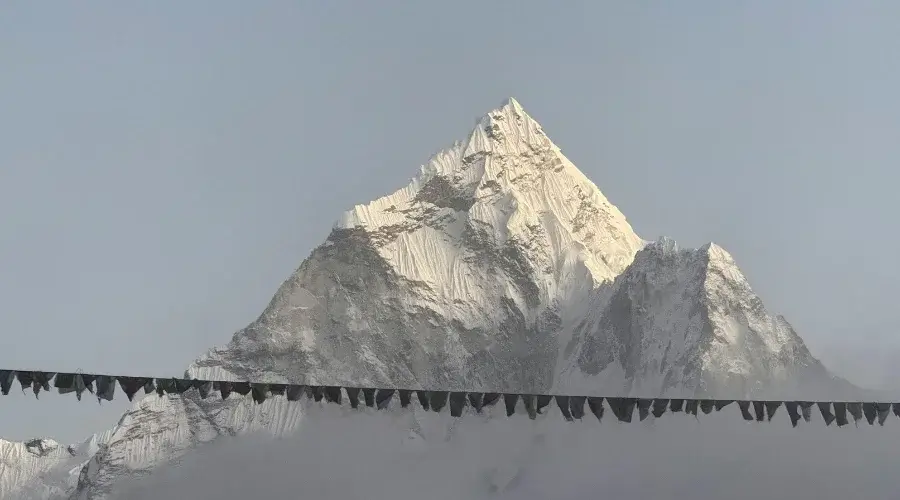
Overnight in Kothe.
Day 14: Trek to Thuli Kharka
Altitude: 4320m
Duration: 6-7 hours
Following the path we are already familiar with, we slowly walk to Thuli Kharka. We only cover a short distance a get to the camp earlier. Reaching here, we interact with the locals and explore the village around us. It’s a day to understand the unique culture of the Sherpa people.
Overnight in Thuli Kharka
Day 15: Trek to Lukla
From Thuli Kharka, we shall first head south towards the Zatrawal pass. Here, we stop for the exciting panorama of mountains for a while. Next, we shall head downwards to the Lukla. This will take a couple of hours of smooth walk. In the evening, we celebrate a farewell with the team. The Sherpas and porters leave us at Lukla.
Overnight in Lukla
Day 16: Fly to Kathmandu
The flight from Lukla to Kathmandu is usually scheduled in the morning. If the weather is unstable, we might have to stop here for a few days. From Lukla, we fly to Kathmandu airport in only 25 minutes. At the airport, a driver will already to waiting for your arrival. Arriving at Thamel, you will have time to recover from the trek. Also, take some time aside for souvenir shopping. In the evening, we can again gather for a farewell dinner.
Overnight in Kathmandu
Day 17: Departure
In Kathmandu, you will have a wonderful breakfast. Then, a private driver will pick you up as per your flight schedule. You will be dropped off at the airport, a few hours before the flight time. Then, it’s time to fly back to your home country with the wonderful memories of the trip.
So, did this trip make you excited? If yes, book your trek with Himalayan masters and be served with the best possible facilities. We are committed to giving you a memory you shall cherish for a lifetime. You can book our trip or contact us from the booking form here or even leave a comment below.
include / exclude
Trip Cost Includes
- International airport pick-up and drop-off by private car
- A three-night hotel in Kathmandu with breakfast
- A professional English-speaking trekking guide during the trekking
- An experienced porter during the trek
- Breakfast, Lunch and dinner during your trekking and expedition
- Basic twin-sharing tea house accommodations In the mountains.
- Sagarmatha National Park permits
- Mera peak permits
- Kathmandu to Lukla to Kathmandu airfare
- Guide Flight Ticket
Mera Peak climbing Cost includes
- a one-night tent stay at the island peak base camp
- and one-night tent accommodation at Island Peak High Camp.
- Breakfast, lunch, and dinner during base camp and high camp, and tea and coffee are unlimited.
- A climbing sherpa for Mera Peak 2 sherpas for three clients (Private guide)
- Guide insurance
The Complimentary service from The Himalayan Masters
- A 25-degree sleeping bag during the trip.
- Down jacket during the trip.
- Water bottles and purification tablets by Himalayan Masters
- first aid kit box.
- Himalayan Masters Brand Duffle Bag for the Trip
- Himalayan Masters Brand Trekking T-Shirt and Cap
- Farewell dinner in Kathmandu by Himalayan Masters Team
- Climbing gears for the Mera peak climb
Trip Cost Excludes
- an international flight ticket
- Tips for Climbing guides, porters and base camp staff
- Lunch and dinner in the city
- WiFi, battery charging, and hot showers in the mountains
- Travel Insurance
- Your expenses
Other things that have not been mentioned above are also on the exclusion list.
useful info
How Difficult Is Mera Peak Climbing?
How hard is it to climb Mera peak? The Mera Peak Difficulty is high but not like Everest or Annapurna. On the 14 trekking days, we will walk 5 to 7 hours daily. The total distance of the Mera Peak climb is about 150 km. You should be physically fit to cover this distance, especially without heart or lung disease. Before the tour, exercise like jogging, running, swimming, cycling, push-ups, squats, etc., to prepare your body. You must practice these exercises for several months before landing in Nepal to lower the Mera peak difficulty.
Mera Peak Elevation
How high is Mera Peak? Mera Peak is 6,476 meters (21,247 feet) high, making it one of the tallest trekking peaks in Nepal. It’s located in the Himalayas and offers amazing views of some of the world’s highest mountains, including Everest and Lhotse. Climbing Mera Peak is popular because it combines high altitude with a route that many trekkers can manage, providing a thrilling adventure in the mountains.
Altitude Sickness During Mera Peak Climbing
As with all high-altitude treks, the Mera peak trekking also bears the risk of altitude sickness. The sudden shift of altitude from Kathmandu to Lukla (1400m to 2860m) can be troublesome for anyone. As you climb to the Mera Peak altitude of 6,461 meters, air pressure can take a toll on the human body and increase the Mera Peak difficulty.
Acute Mountain Sickness (AMS) causes symptoms such as nausea, insomnia, loss of appetite, and diarrhea. These symptoms can be moderate for some and fatal for others. In severe cases, you may need to walk back to a lower altitude and even require a helicopter due to extreme conditions. This is why we don’t suggest climbing at Mera peak elevation for solo trekkers.
Mera Peak Technical Difficulty:
Trekking Mera Peak also demands technical climbing skills. But you don’t need this training beforehand- the guide will teach you simple ways to use crampons, ropes, and axes before you head for the trek.
Note: In a single trip, some people also include Mera Peak and Island Peak or Mera Peak and Lobuche Peak climbing. Before you do that, we suggest analyzing Mera Peak vs Island Peak and then climbing one at a time. With a responsible team, you are likely to be fine.
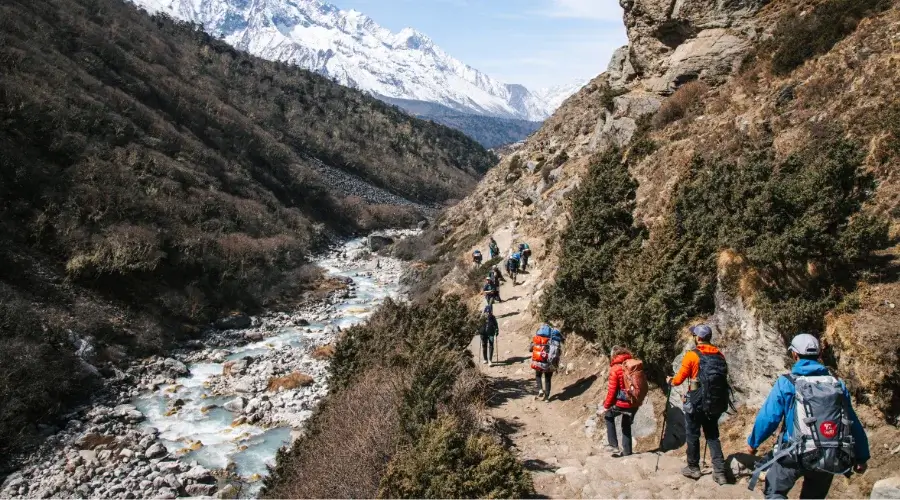
How Much Does Mera Peak Climbing Cost?
The Mera Peak climbing cost is USD 2305, including all essential items you require for a trek.
Before knowing this, you need to have two kinds of information. Firstly, Mera Peak climbing is a total camping trek for one night at the Mera Peak Base Camp. This means you must carry all food and camping material from Kathmandu, which requires additional porters and cooks.
However, Mera Peak climbing cost is cheaper than real mountain climbing, where you need to issue a costly climbing permit and hire professional climbers.
With Himalayan Masters Mera Peak climbing cost, you can travel for less than $2500. We offer the best price for excellent facilities. Mera peak climbing cost for Nepali can go down to about Nepalese rupees of 1 lakh if you don’t hire many porters and travel with a minimum facility.
Also Read:- Nar Phu Valley Trek In Nepal
Mera Peak Climbing Permit Cost
Do you need a permit to climb Mera Peak? Yes, you do need a Mera Peak Permit. This permit is required for all climbers and can be obtained through a registered trekking agency in Nepal. The permit ensures that climbers are allowed to enter the region and ascend the peak legally. It’s important to arrange this permit before starting your trek to avoid any issues during your expedition. Summiting the Mera Peak expedition requires Mera Peak permit cost varying by season.
- Spring (Mar-Apr-May) costs USD 250
- Autumn (Sep-Oct-Nov) USD 125
- Winter (Dec-Feb) USD 70, and
- Summer (Jun-Jul-Aug) USD 70.
- Additionally, a USD 250 garbage charge is collected (mandatory).
- National park permits for Sagarmatha and Makalu Barun cost USD 30 each.
- A local community fee of NPR 2000 supports trail improvement during the Mera Peak Climbing.
Mera Peak Emergency And Evacuation
Lukla has a hospital and an airport for your rescue if there’s an emergency during your Mera Peak Climbing. Evacuating someone by helicopter depends on the Mera peak weather and visibility. In an emergency, the team, guide, and nearby helpers will work together to move the person to a safe spot.
Helicopter evacuation can be organized through your insurance, but you must talk directly to the insurance company. To do this, share your policy number, name, address, and the date you paid for the insurance policy. It’s important to communicate these details to open a case and explain the situation. It is a must to have travel insurance by yourself to cover all these fees.
Mera peak packing list
Prepare for your Mera Peak trekking adventure with the Mera Peak packing list:
– Pack a large duffle bag or backpack
– A 45-litre daypack,
– waterproof stuff sacks, and
– An expedition jacket (Primaloft or down).
– Keep warm with a Goretex waterproof jacket
– Trousers
– Fleece tops and base layers.
– Ensure proper footwear with mountaineering boots graded B1 or B2 for crampons.
– Include trekking boots.
– Accessories like sunglasses
– Gloves
– Hats.
– Your kit should also have a 4-season sleeping bag.
– A thermoset or thick foam sleeping mat and basic mountaineering tools such as crampons, a harness, a walking axe, and climbing slings.
Footwear and First Aid Considerations
Choose boots that fit well, are warm, and allow crampon use. B1-graded boots are suitable for climbing Mera Peak. Keep your first aid kit simple with pain relievers, wound care items, antihistamines, sun protection, and medications as needed. Include altitude sickness prevention like acetazolamide tablets (Diamox) with a prescription. With these essentials, you’ll be well-prepared for a safe and comfortable climb to Mera Peak.
Mera Peak Climbing Best Time and Route
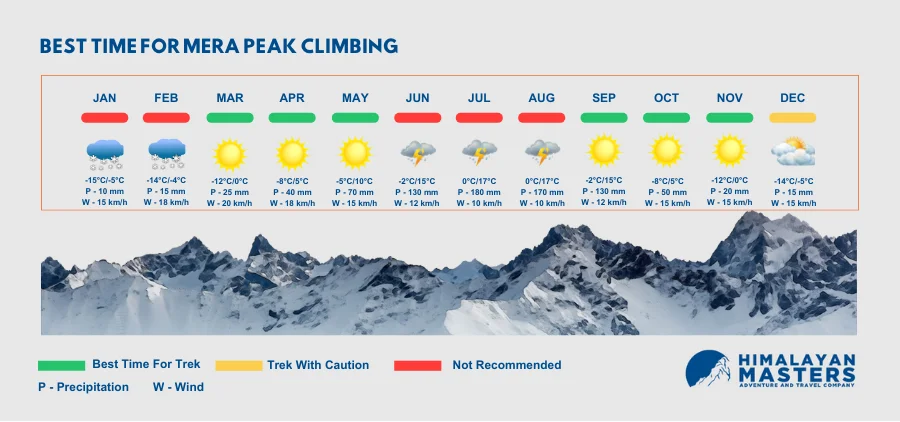
After exploring cultural sites in Kathmandu, we fly early to Lukla, the Gateway to Everest. Our journey starts with a walk through a Sherpa village, following the mountaineering tradition.
We gradually ascend, passing Zatrwa La pass to reach ThuliKharka. Moving to Kothe, then to Thangnak for acclimatization, we continue to Khare, the last teahouse stop.
Next, we head to the high camp, spend a night in a tent, conquer Mera Peak trekking, and return along the same route.
Himalayan Masters ensures a hassle-free and quality service experience and carefully plans for acclimatization and health.
Mera Peak Weather
The Mera Peak weather varies greatly depending on the season. During the peak climbing seasons of spring (April to May) and autumn (October to November), the weather is generally stable with clear skies, providing excellent visibility and stunning views of the surrounding Himalayas. Daytime temperatures at lower elevations can be pleasant, while higher up, especially near the summit, it can be quite cold with temperatures dropping well below freezing.
The monsoon season (June to September) brings heavy rainfall and cloudy conditions, making it less ideal for climbing Mera Peak. Winter (December to February) can be extremely cold, with heavy snowfall and harsh conditions, making the climb more challenging. It is important to prepare for a wide range of weather conditions when planning a Mera Peak expedition.
Also read: Gokyo Lake Trek.
Best Season for Mera Peak Climbing
Let’s talk about Mera Peak weather. Choosing the best time to climb Mera Peak is crucial considering the four seasons.
Due to stable weather conditions, spring and autumn are the best periods. During spring (March to May), nature rejuvenates, and the Mera peak weather is warm, making the climb enjoyable.
Autumn (September to November) is even more favourable, offering clear weather, low chances of sudden changes, and a festive atmosphere in Nepal.
Winter (December to February) is an adventurous option, with chilly Mera peak temperature but less crowded routes.
Climbing in monsoon (June to August) is not recommended due to heavy rainfall and muddy trails, but early June or late August might provide clearer skies after the rain.
Accommodation In Mera Peak Climbing
Mera Peak climbing has three kinds of accommodation depending on the season and route. The first one is hotels in Kathmandu. You will visit three-star hotels in Kathmandu that are pretty luxurious and have all the necessary amenities. You can have an attached bathroom in the room with a hot shower. Also, there are other unlimited options for hotels in Thamel, and you can switch to higher facilities of your own.
Tea houses/ local lodges:
In the lower region, i.e., up to Namche, we will be staying in tea houses—small yet comfortable local lodges. The rooms only have two single beds, a mattress, pillows, and a clean white sheet. However, the option of a tea house is only available for the lower region.
Mera Peak Base Camps:
In the higher region, above Namche, we stay in a tent/ camp. We will primarily be carrying all your food and accommodation for the 17-day climbing Mera peak Nepal . The porters from Himalayan Masters will help you take everything to the camp and set up the tent for the night. The cooks will prepare your food, and you can trek easily.
Trekkers can choose any accommodation of their preference for the lower altitude—either the tea house or the camps. But as we move higher, we cannot find the tea houses and thus stick with the camps. Camping in Nepal can be tricky (and expensive), but it’s a true adventure into nature.
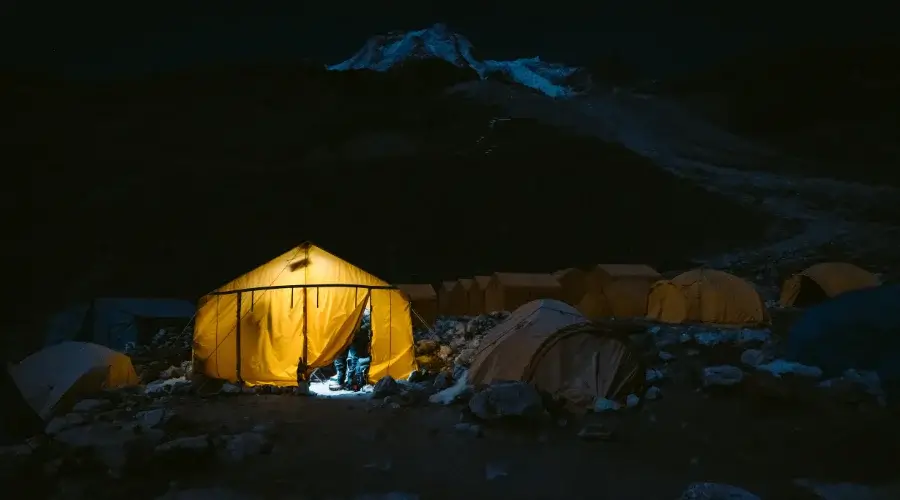
Electricity and battery recharge, water during the trek
When going through the Mera Peak climbing expedition, the availability of electricity and charging of batteries for use by communication devices and other equipment is significant. Charging requires a power source, and as you may know, there are no electrical outlets up at the mountain, and most climbers use portable solar panels to recharge their devices. Charging may also be extended for emergencies, and thus, it is advisable to have an extra battery or a power bank.
As for water sources, climbers can only drink from plastic containers, treat it with iodine tablets or filters, or boil the water. One must drink large quantities of fluids to avoid altitude sickness, which is inevitable at high altitudes during the climb.
With Himalayan Masters
Booking/ airport pickup
Himalayan Masters will help you organize the Mera Peak climbing expedition and provide you with everything you need for your climbers. They usually organize pickup and drop services when you get down in Kathmandu and transport you to your accommodation.
Support team
During this journey, they will be accompanied by a team from Himalayan Masters to guide them all the way. This team comprises qualified guides and porters who are conversant with the ground and are always ready to help throughout.
Starting and ending point of Mera Peak Climb
Lukla in the Khumbu region of Nepal is one of the most common starting points for the Mera Peak climb. Although it is the best entry point to the region, trekkers have to walk through forests, report at several villages, and stay at different teahouses.
The ascent ends at the top of Mera Peak, where one can admire a great view of several other peaks of the Great Mountains. On descending, the trek usually concludes at Lukla, where one takes a flight back to KTM.
A typical day on the Mera Peak Climbing
A typical day during the Mera Peak climbing expedition starts early, around 6:00 AM. Most trekkers have tea or coffee for breakfast and some light snacks before repacking their backpacks for the day’s trekking. The trek usually begins around 7:00 AM to travel a particular distance for lunch.
In mid-afternoon, the group takes a break and rests at a beautiful place or a tea house for lunch. This is a good opportunity to have a break, eat a warm meal, and have a little nap before continuing in the afternoon. The afternoon trek is typically less lengthy as it must allow for arrival at the destination for the day by the end of the afternoon.
Trekkers relax in their rooms when arriving at the teahouse or lodge for the night. Dinner is served early, around 6:00 PM to 7:00 PM, and it is a strong Nepali meal that provides you immense diet and protein.

Insurance for Mera Peak
It can be highly advisable to take travel insurance that includes high-altitude trekking and climbing, such as the Mera Peak activity. This insurance should also cover emergency medical evacuation since this can be costly, especially in the remotest part of the country.
Mera Peak Climb additional Expenses
However, several other expenses must be considered when planning the trekking trip. These may include ranger fees, equipment hire, porter and guide tips, additional food and beverages, communications and internet fees, and mementoes.
ATM along the Mera Peak Climbing Route
While ATMs are in Kathmandu, Lukla and Namche Bazaar. So, carrying enough cash for your trek is advisable as ATM availability can be limited and unreliable. Most teahouses along the trekking route do not take credit cards, so cash is the preferred form of payment.
FAQs
Can beginners climb Mera Peak?
Yes, Mera Peak is a trekking peak that the beginner’s trekkers can complete. It would help if you had some technical climbing training and acclimatization before the trek, but after some preparation, it is definitely possible for a newbie to complete this trek.
Is Mera Peak Better than the Everest Base Camp?
Can you see Everest From Mera Peak?
Is Mera Peak worth it?
Is Mera Peak a technical climb?
Can I climb Mera Peak without a guide?
What is Mera Peak's success rate?
What is the hardest peak in the world?
How do I prepare for the Mera Peak trek?
How many days do you need for Mera Peak?
Can you climb Mera Peak Solo?
What is the elevation gain of Mera Peak?
What are the fees and documents required to get a Nepal Visa?
Will I get hotel transfers during my arrival and departure?
How long is the Mera Peak climbing?
Do we need to carry an oxygen cylinder and Gamow Bag?
Should I carry any extra cash during Mera Peak's Journey?
How much to tip a guide or porters? Is it necessary?
What kind of food should I expect during the trek?
What internet/telephone services are possible on the Mera Peak Expedition?
Speak to an Expert





Sandip Dhungana
Nepal 🇳🇵
Whatsapp: +977-9823636377
Speak to an Expert





Sandip Dhungana
Nepal 🇳🇵
Whatsapp: +977-9823636377


